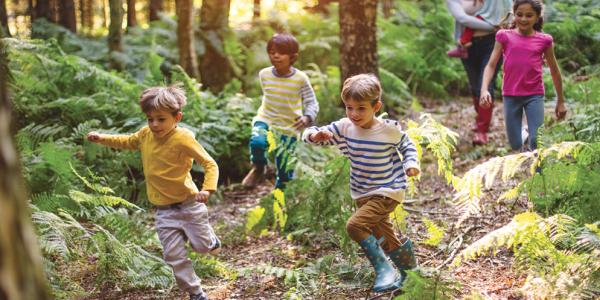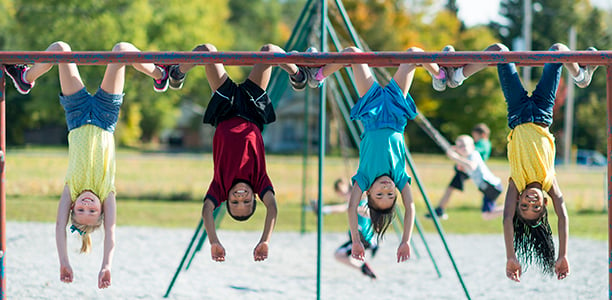82
Teacher’s lack of confidence
It can be argued that taking the lessons outside of the familiar in-door classroom comes as a challenge to many teachers as they need to adapt their lessons to the real world outside and analyse the relevance of the content in an outdoor environment (Liebermann & Hoody, 1998). Proposing a whole school approach and scheduling regular meetings with other staff members to share ideas and reflect on the outcomes will help teachers establish confidence and deepen their knowledge. Viewing outdoor learning as a complement to indoor learning rather than an isolated way of teaching will be a vital step for successful implementation.
Think and reflect
What would be your personal concern/challenge when taking an inclusive classroom outside?
Additionally, teachers may fear to not have their children under control, and some interpret an outdoor environment as dangerous and a potential risk of injury. Waite and Davis (2007) argue how learning outcomes in relation to the usual lessons are less predictable and more investigative. This aligns with the fear of wasting valuable time and not being able to connect it to the existing curricular objectives. However, this can be prevented by setting clear boundaries and rules with the whole class before going outdoors. Teachers should first establish good classroom management indoors and research which places are available for them to use purposefully (Education World, 2001) and are accessible for all students.

The main thing to do in situations where the unexpected happens, is to keep a sense of calm. Teachers should not be afraid to make tough decisions to call off or cancel an activity if it has potential to become dangerous or too difficult to manage.
(H. Kerr, personal communication, November19, 2020)
Furthermore, teachers’ lack of confidence results in concerns about safety. The fear of dangerous scenarios and students hurting themselves is always present. Nevertheless, taking risks should be encouraged as a natural part of learning, indoors as well as outdoors, and benefits childrens’ development as they explore their environment in a more holistic approach (Chantrell, 2015). Teachers’ confidence will enhance once they move their lessons outside and let the children see the connections between the environment and the subjects taught. Moreover, it will also help all learners as well as the teacher itself overcome challenges and supports social inclusion and interactions.
Think and Reflect
How do you think you can overcome the challenges you thought of at the beginning of this section?
Curriculum limits and school policy
Depending on the school’s location outdoor learning lessons might require more planning and bureaucratic requests in advance. There is much to be considered in order to ensure all childrens’ safety and the planning can seem overwhelming especially doing it the first time. Cremin and Arthur (2014) have provided a great checklist (see appendix b) to make the planning process as easy and structured as possible. If you are planning on taking the class out regularly, speak to the head of school to find the best and safest long-term agreement. Also, invite parents in the planning process and listen to their concerns. It is important to plan transparently and do not leave caregivers with open questions as they need to have the certainty that they dismiss their children into a safe school environment at all times.

Outdoor education is not just about adventure and learning happens automatically, but it demands a well-planned structure and meaningful curriculum links. Start by checking the curriculum requirements and state individual learning outcomes for each student based on this. It is very important to communicate the learning goals so your students can focus on these expectations. A precise preparation as well as an in-depth reflection afterwards makes the outdoor experience meaningful and educational. At first glance it might seem very challenging to connect core subjects like Maths and Language to outdoor experiences but our activity ideas as well as a list of great websites (starting on page 18) will help you to offer wonderful learning experiences in nature.
Inclusion of ALL
Students with a disability can experience limitations when learning in the outdoors. This can lead to an obstacle for their participation. Not being able to access the learning can have serious consequences for students’ development (Brodin, 2009). Learners that cannot fully participate could experience social exclusion from their peers and it can have negative effects on their physical, mental and emotional health. For students in primary school this can result in a lower self-esteem, feelings of anxiety, distress and aggression (DeWall, Deckman, Pond, & Bonser, 2011).
Fortunately, outdoor education seems to promote inclusion of students with a disability rather than excluding them (Doctoroff, 2001; Spencer, 2003). It even results in a better understanding of differences and limitations among students (Brodin, 2009).
Educators play an important role in creating this safe and inclusive learning environment.
| Step 1: | Step 2: | Step 3: | Step 4: | Step 5: | Step 6: |
| Develop a resource base | Address personal attitudes | Obtain specific information | Develop necessary adaptations | Implement programs | Evaluate process |
The model of Inclusive Facilitation (Sugerman, 2001)
According to Brodin (2009) it is the responsibility of the educator to create suitable activities for all students through adaptation and a high-quality design of the outdoor environment. This can make students more alert to the boundaries and expectations. It is also beneficial for the teacher to prepare any additional support in advance to avoid any barriers later on in the process.
Sugerman (2001) created the model of Inclusive Facilitation which can be found below. This model shows structured guidelines of how teachers include students for who it might be challenging to participate in learning activities. Even though this model focuses on inclusion in general it is a very good model to implement in outdoor education activities as well.
The model explained
The main focus in the first step of the model is the creation of a support structure. This can include written resource material, professionals and/or people who have more experience with the disability of the student. This network should be established before designing any activities as it can be a great support network for the educator.
After the support network has been established it is essential for the teacher to recognize and understand his/her own attitude towards the disability of the student. This can help the teacher in changing any attitudinal barriers and help to understand the different values and beliefs towards the specific disability.
When the educator completes this self-evaluation, it is of great importance to find out more specific information about the particular student and the disability. Doing research on the disability can help the teacher to get some general ideas. However, to avoid prejudices it is important to gather information from the student itself. Often the student is the expert of the disability.
If the educator feels like the student needs any possible adaptations or modifications the teacher could implement this in the lesson planning. There could be adaptions in the procedures, equipment and skill sequence. Modifications could be made to the environment or the program.
If the educator completed these first four steps the support program that is created can be implemented. In this phase the educator does not only consider the adaptations and modifications of the student, but also the social integration through for example, setting guidelines or modelling respectful behaviour.
THINK AND REFLECT
As a teacher, how would you support the social integration of your student with a disability?
After the learning is completed a reflection should take place. A reflection can help in recognizing any strengths and weaknesses of the support program. These can then be used to improve the program and make it even more effect for students.
You don’t ‘know’ or can’t predict what creativity looks like until it happens.
(S. Bennett, personal communication, November 17, 2020)
